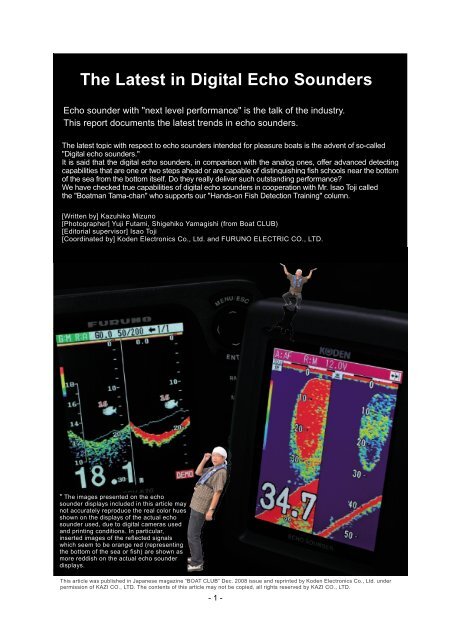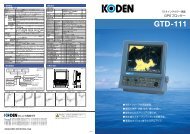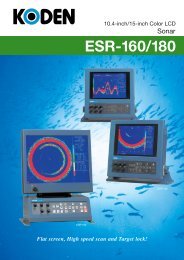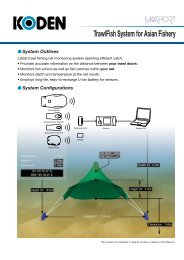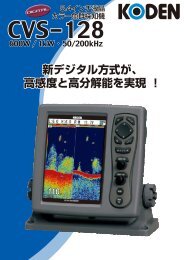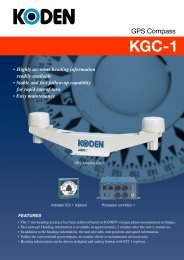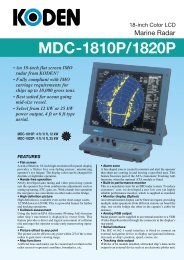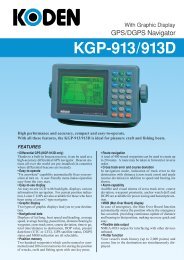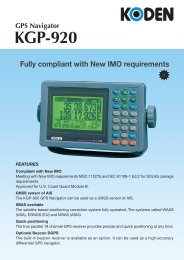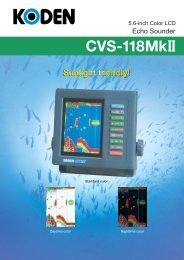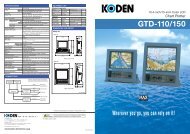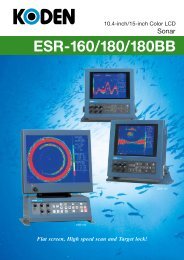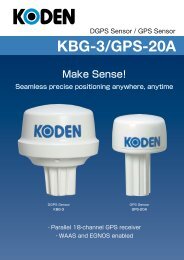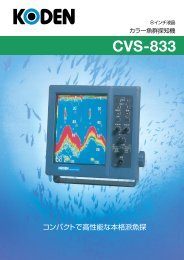Create successful ePaper yourself
Turn your PDF publications into a flip-book with our unique Google optimized e-Paper software.
How does a digital echo sounder workTransducerNow, how does the digital echo sounder work? It amplifies reflected signals captured <strong>in</strong> the similar manner as theanalog one. However, the digital echo sounder does not extract the amplitude <strong>in</strong>formation from them but directlyperforms digital conversion for visualization. <strong>The</strong> digital echo sounder carries out subsequent processes until it showsthe data on its display, entirely <strong>in</strong> a digital manner. Because of this, the digital echo sounder is sometimes called "fulldigital echo sounder" as opposed to the analog one.<strong>Digital</strong> conversion (A/D conversion) is carried out by divid<strong>in</strong>g cont<strong>in</strong>uous analog signals at predeterm<strong>in</strong>ed short<strong>in</strong>tervals to digitize them at each division po<strong>in</strong>t (Fig. 1). For direct digital process<strong>in</strong>g of analog reflected signals, theecho sounder has to carry out A/D conversion at a very high speed, and also has to read and process the converteddigital data at an <strong>in</strong>creased speed. Recently, high-performance A/D converters and high-speed digital process<strong>in</strong>g<strong>in</strong>tegrated circuits became available at reasonable costs, thereby mak<strong>in</strong>g digital process<strong>in</strong>g more and more popular.Under those circumstances, digital process<strong>in</strong>g has been <strong>in</strong>troduced <strong>in</strong> compact-sized echo sounders.One of the advantages of digital signal process<strong>in</strong>g is to enable process<strong>in</strong>g of complicated and diversified data. <strong>The</strong>process<strong>in</strong>g of such data might need extremely large circuits if it is to be done by means of analog filters and be hard toimplement. But, it can be easily done only by chang<strong>in</strong>g a program by means of digital filters. This means that the echosounder can be made smaller if us<strong>in</strong>g digital filters.- 3 -
Advantages of the digital echo sounderWith the digital echosounder, for example, the band-pass filter's receiv<strong>in</strong>g bandwidth (range of frequencies ofultrasonic waves to be received) can be changed depend<strong>in</strong>g on the range of sea depth. <strong>The</strong> pulse width (lengthof ultrasonic waves to be sent) can be shortened to improve the range discrim<strong>in</strong>ation (capability of separat<strong>in</strong>gadjacent reflected signals from each other for easy discrim<strong>in</strong>ation between them) by widen<strong>in</strong>g the bandwidth.Let's assume a fish school is swimm<strong>in</strong>g near the sea bottom. When the fish school is at a certa<strong>in</strong> distance from thesea bottom, signals reflected from the fish school and those reflected from the sea bottom should be presentedseparately <strong>in</strong> a dist<strong>in</strong>ctive manner. If the band-pass filter's response is slower, however, those signals would beoverlapped when pass<strong>in</strong>g though the filter and could not be discrim<strong>in</strong>ated.To prevent this, the bandwidth is widened to pass shorter pulses through the filter, the filter's response speed will be<strong>in</strong>creased to enable the echo sounder to give images of the reflected signals from the fish school and those from thesea bottom separately and dist<strong>in</strong>ctively on the display. Noise will <strong>in</strong>crease by broaden<strong>in</strong>g the bandwidth. This will notcause a problem at shallow depths of the sea where the magnitude of reflected signals from fish schools is great.On the contrary, at greater ocean depths, ultrasonic waves are likely to spread (ultrasonic waves transmitted by theecho sounder toward the sea bottom spread <strong>in</strong> a conical shape), the range discrim<strong>in</strong>ation near the sea bottom cannotbe expected by its nature. <strong>The</strong>refore, it may be better to send ultra sonic waves of a broader pulse width which canreach deeper sea bottom and narrow the bandwidth <strong>in</strong> order to reduce the noise.To enable the analog echo sounder to select the optimum bandwidth accord<strong>in</strong>g to the depth of the sea <strong>in</strong> thisway, two or more analog filters had to be prepared (this was practically impossible). For the digital echosounder, however, the bandwidth selection can be easily done only by means of one digital filter. As a result,when compared with the analog echo sounder, the digital one can present images of reflected signals withhigher range discrim<strong>in</strong>ation at shallow depths of the sea and to present clearer images with a less powerfultransducer at greater depths of the sea.With respect to noise rejection, the digital echo sounder permits easier process<strong>in</strong>g s<strong>in</strong>ce it can directly digitizereflected signals. This process may be easy to be understood if you th<strong>in</strong>k of radio signals. If electro magneticsignals received are converted <strong>in</strong>to audible sound, it will be difficult to reject noise from it. <strong>The</strong> analog echosounder is similar to the radio <strong>in</strong> this po<strong>in</strong>t. If the analog echo sounder converts reflected signals to amplitudesignals, it will be difficult to reject noise from them.In addition, the digital echo sounder can filter out or enhance certa<strong>in</strong> signals with considerable accuracy forreject<strong>in</strong>g noise, etc. It can "adjust" signals accord<strong>in</strong>g to the conditions with more flexibility than the analogone, for adjustment of reject<strong>in</strong>g reflected signals from other small objects than fish or enhanc<strong>in</strong>g reflectedsignals from fish. From the next page, let us describe the actual models while pay<strong>in</strong>g attention to thoseadjustments.- 4 -
<strong>The</strong> echo sounder is safely <strong>in</strong>stalled on the opencockpit s<strong>in</strong>ce its body is waterproof. <strong>The</strong> viewabilityof the LCD display under the direct sunlight isconsiderably improved as compared with itspredecessor models. This is the first model fromKODEN that is equipped with a sea tide graph .KODEN CVS-126 <strong>Echo</strong> SounderImpressions from the-shipboard test 1We have subjected two different models of digital echo sounders to a sea trial.One was "KODEN CVS-126" <strong>in</strong>troduced at the Boat Show <strong>in</strong> the spr<strong>in</strong>g of 2008. This is one of the latestmodels that not only promises improved image representation which is specific to digital echo soundersbut also permits GPS connection, stores images and has improved capabilities such as alarm<strong>in</strong>g of fishschools. Let's see how Mr. Toji has evaluated this model.<strong>The</strong> KODEN CVS-126 gives smooth images of the sea bottom features on thedisplay.<strong>The</strong> echo sounder was brought <strong>in</strong>to Mr. Toji's boat (DAI-NI TAMANEGI-MARU) for the sea trial. <strong>The</strong> transducer was put<strong>in</strong>to the sea directly over the side to check images of reflected signals given on the display at depths of 10, 50, 150 and 300meters. <strong>The</strong>n, the same test was carried out with an analog echo sounder at the same depths for the purpose ofcomparison. It should be noted that the test was performed on one-by-one basis s<strong>in</strong>ce us<strong>in</strong>g two transducers with samefrequency at a time would cause <strong>in</strong>terference between the two. <strong>The</strong>refore, we have to tell you <strong>in</strong> the first place to rememberthat the comparison display images shown side by side <strong>in</strong> the pictures shown on the subsequent pages do not representexactly the same reflected signals.We commenced the test on the KODEN CVS-126. It has two different frequencies 50 and 200 kHz and output power of600 watts. It is equipped with a 5.7-<strong>in</strong>ch color LCD. As compared with KODEN's analog models, the design has beenchanged to achieve simplified control layout."This digital echo sounder is really easy to use. Such simple and large switches are very convenient s<strong>in</strong>ce they can beoperated without look<strong>in</strong>g once we get familiar with them. <strong>The</strong> display has a wide view<strong>in</strong>g angle and sufficient brilliance, andis very friendly to eyes." (Mr. Toji)First, we moved to shallow depth area to f<strong>in</strong>d a horse mackerel fish<strong>in</strong>g po<strong>in</strong>t on Toji's boat. Unfortunately, we could notf<strong>in</strong>d large schools of horse mackerel as we expected."Well, it is difficult to get images of same reflected signals from fish on both the digital and analog echo sounders. Still thedigital echo sounder gives smooth images of bottom contours. It gives clear view of small dents there. <strong>The</strong> imagesappear<strong>in</strong>g on the analog one have, somewhat, rough texture. I th<strong>in</strong>k this difference <strong>in</strong> presented images is caused by adifference <strong>in</strong> range discrim<strong>in</strong>ation. <strong>The</strong> digital echo sounder has a higher discrim<strong>in</strong>ation."<strong>The</strong>n, we moved to different po<strong>in</strong>ts the depths of which were 50 m and 150 m. Accord<strong>in</strong>g to the manufacturer(KODEN), the device, be<strong>in</strong>g fully digital, will achieve the same performance under the AUTO mode as under theMANUAL operation, we decided to operate the device under the AUTO mode throughout the test<strong>in</strong>g.Furthermore, the CVS-126 is provided with capabilities to shift images of the sea bottom smoothly from one range toanother without show<strong>in</strong>g an abrupt difference <strong>in</strong> height when the device automatically changes its range under theAUTO mode, and to <strong>in</strong>crease the sensitivity from the current image appear<strong>in</strong>g on the display, <strong>in</strong>stead of a new image tobe displayed, when the operator selects an <strong>in</strong>creased sensitivity. Those functions are achieved by enabl<strong>in</strong>gcomplicated process<strong>in</strong>g of reflected signals through fully digital circuits.- 5 -
Images of underwater area around a depth of 10 mCVS-126Analog echo sounderFor both echo sounders, images obta<strong>in</strong>ed at twodifferent frequencies are given at a time (theright half <strong>in</strong>dicates 200 kHz and the left half 50kHz). It should be noted that, for the analogecho sounder, the sea bottom appears jagged,but, for the CVS-126, the sea bottom appearssmooth. We can’t tell for sure whether thereturned echo near the sea bottom representsfish. Still, details of the returned echo appearclearer on the CVS-126 than on the analog one.At a frequency of 50 kHz, the signals reflectedfrom around the target area are comb<strong>in</strong>ed tomake one solid projection of the sea bottompresented on the left part of the display. At afrequency of 200 kHz which is narrower <strong>in</strong> beamwidth, however, the same reflected signals arepresented separately from the sea bottom.Images of underwater area around a depth of 60 mCVS-126Analog echo sounder<strong>The</strong> CVS-126 shows fa<strong>in</strong>t reflected signals fromplankton or the like near the sea bottom. S<strong>in</strong>cethe digital echo sounder does not show an objectwhich does not reflect signals, the result<strong>in</strong>gimage is clear. Reflected signals capturedaround a depth of 20 meters are not displayed onthe analog echo sounder. We believe that thehighly possible reason is, for the purpose of thistest, that there was noth<strong>in</strong>g <strong>in</strong> the <strong>in</strong>termediatelayer of the sea. We also suppose that thereason why the analog echo sounder does notvisualize fa<strong>in</strong>t reflected signals is that the devicetakes reflected signals which are weaker than acerta<strong>in</strong> level as just noise and forcibly cuts them.Anyway, thanks to digitalization, the digital echosounder gives clear and crisp images on itsdisplay with no noise <strong>in</strong> the areas immediatelyunder the sea surface and the <strong>in</strong>termediate layerof the sea.Clear and crisp images on the displayIn the area deeper than 150 meters, the analog echo sounder could not capture the image of the sea bottomwith a frequency of 200 kHz. However, the CVS-126 gave clear images of the sea bottom even with a frequencyof 200 kHz. In addition, the display does not show fa<strong>in</strong>t reflected signals captured <strong>in</strong> the surface and<strong>in</strong>termediate layers of the sea but clearly shows the sea bottom <strong>in</strong> red. In fact, the CVS-126 shows clearer andcrisper images on the display as compared with the analog echo sounder."This may be because the relation between the depth of water and ga<strong>in</strong> (sensitivity) of the device is adequatelycorrected. In other words, the more the depth <strong>in</strong>creases, the greater the attenuation of ultrasonic wavesbecomes. I guess that the device can correct the ga<strong>in</strong> enough to give clear and crisp images on its display. Ith<strong>in</strong>k this is the technique which can only be achieved by a digital echo sounder."When the depth exceeded 300 meters, the CVS-126 gave images of the sea bottom on the 200 kHz sidedisplay. Mr. Toji told us "<strong>The</strong> device may narrow the bandwidth as far as possible." We confirmed at the end oftest that the device gave clear images of the sea bottom at a depth of 730 meters with a frequency of 50 kHz.For your reference, the manufacturer’s staff expla<strong>in</strong>ed to us that the CVS-126 could give images of the seabottom as deep as approximately 800 meters (with a frequency of 50 kHz) if we needed images only of the seabottom. <strong>The</strong> analog echo sounder, on the other hand, could only give images of the underwater zone at adepth of 600 meters at the maximum with a frequency of 50 kHz and the images conta<strong>in</strong>ed lots of noise. Whencompar<strong>in</strong>g those two types of the echo sounders, we may say that the bandwidth adjust<strong>in</strong>g function and noiserejection performance that are specific to the digital one considerably improve deepwater sound<strong>in</strong>gcapabilities.- 6 -
<strong>The</strong> <strong>Latest</strong> <strong>in</strong> <strong>Digital</strong> <strong>Echo</strong> <strong>Sounders</strong>FURUNO FCV-620 is a watertight echosounder suitable for <strong>in</strong>stallation on theopen cockpit of a boat. It is provided withfunctions <strong>in</strong>tended for bass or sea-bassfish<strong>in</strong>g such as high-speed detectioncapability <strong>in</strong> the shallow-depth range. Italso has the sea tide <strong>in</strong>dicat<strong>in</strong>g functionand the function to output data onto a GPSplotter. <strong>The</strong> advanced FCV-585 Series hasa model with an output power of 1 kW.FURUNO FCV-620Impressions from the shipboard test 2FURUNO FCV-620 is a digital echo sounder which has been launched on the market <strong>in</strong> 2006.It has specifications for achiev<strong>in</strong>g ease-of-use when <strong>in</strong>stalled on small boats, tak<strong>in</strong>g its use for bassor sea-bass fish<strong>in</strong>g <strong>in</strong>to account.It is still a fresh memory that the FCV-620 echo sounder added excitement <strong>in</strong> the pleasure boat market,with its world's first and unique capability of <strong>in</strong>dicat<strong>in</strong>g the size of fish. It still is one of the very popularmodels of echo sounders available on the market.Relatively simple image representationThis FCV-620 was once featured <strong>in</strong> this magaz<strong>in</strong>e under the title of "<strong>Echo</strong> sounders and GPS New ModelImpressions" when the model was launched on the market. Mr. Toji was <strong>in</strong> charge of evaluat<strong>in</strong>g this model.This time, we have conducted shipboard test<strong>in</strong>g focus<strong>in</strong>g on the comparison between the FCV-620 and theanalog echo sounder.Two different frequencies 50 and 200 kHz are used as <strong>in</strong> the case of KODEN CVS-126 model. <strong>The</strong> outputpower is 600 W, also the same as <strong>in</strong> the case of KODEN's one. <strong>The</strong> FCV-620 has a display screen of 5.6<strong>in</strong>ches and its body is compact. <strong>The</strong> liquid crystal display applied with AR coat<strong>in</strong>g for prevent<strong>in</strong>g reflections ofsunlight has a wide view<strong>in</strong>g angle and is easily viewable under the direct sunlight.<strong>The</strong> operat<strong>in</strong>g section is also simple <strong>in</strong> layout. Not only the ga<strong>in</strong> (sensitivity) sett<strong>in</strong>g but also operation modesett<strong>in</strong>g such as changeover of high/low frequencies and zoomed view selection can be achieved by turn<strong>in</strong>grotary knobs. Accord<strong>in</strong>g to the manufacturer, provision of rotary knobs requires additional cost becausewaterproof<strong>in</strong>g process is essential. It is certa<strong>in</strong> that the knobs achieve improved operability. Users who are notfamiliar with echo sounders may be less nervous when operat<strong>in</strong>g the device by means of the knobs than bymeans of lots of unfamiliar switches.When compar<strong>in</strong>g the images on the display show<strong>in</strong>g actual underwater area with those on the analog one, weare first impressed by the smooth representation of the sea bottom similarly with the case of KODEN's echosounder.What is also impressive is that the oscillation l<strong>in</strong>e (the l<strong>in</strong>e represent<strong>in</strong>g a water depth of 0 (zero) meter) isvery th<strong>in</strong>. For the analog echo sounder, the oscillation l<strong>in</strong>e covers the surface layer of the sea displayed on thedisplay. For the digital echo sounder, on the other hand, the range discrim<strong>in</strong>ation is <strong>in</strong>creased <strong>in</strong> shallow bottomareas of the sea to produce such a th<strong>in</strong> oscillation l<strong>in</strong>e. As a result, images of reflected signals from objects <strong>in</strong>the shallow bottom areas are not hidden under the oscillation l<strong>in</strong>e."Smoothness of the sea bottom seems similar to that <strong>in</strong> the case of the CVS-126. It seems that the twomodels of digital echo sounders are different <strong>in</strong> image representation. <strong>The</strong> CVS-126 corrects images ofreflected signals and sea bottom when giv<strong>in</strong>g them on the display, but the FCV-620 does not make correctionsbut simply presents the images of reflected signals on the display. Still, the latter gives an oscillation l<strong>in</strong>e that issufficiently th<strong>in</strong> and therefore gives easily viewable images on the display."Around a depth of 60 meters, the "ACUFISH function" (for display<strong>in</strong>g the fish size) is used. This function hasbeen developed based on data on reflected signals accumulated <strong>in</strong> FURUNO's echo sounders and is capableof assum<strong>in</strong>g the size of fish based on the strength of reflected signals.- 9 -
Images of underwater area around a depth of 10 mFCV-620Analog echo sounderImages of underwater area around a depth of 60 m<strong>The</strong> <strong>in</strong>serted image picture of the analogecho sounder is the same one as <strong>in</strong>serted <strong>in</strong>the page describ<strong>in</strong>g the KODEN CVS-126.This time, it seems that both echo sounderscapture relatively similar reflected signals.On the rightmost part of the picture of theFCV-620, images of reflected signals whichmight be from fish are displayed. Whencompar<strong>in</strong>g the images of reflected signals onthe FCV-620 with those on the analog one,the former ones are easier to be understoodand changes <strong>in</strong> sea bottom topology belowthose images are clearly displayed. <strong>The</strong>project<strong>in</strong>g part at left of the image of fish-likereflected signals is presented separatelyfrom the sea bottom. For the analog echosounder, such project<strong>in</strong>g part is presented asa part of the sea bottom.When activat<strong>in</strong>g the ACUFISH function, theFCV-620 displays a fish symbol of a 12 cmfish <strong>in</strong> the <strong>in</strong>termediate layer and those of a44 cm fish and 53 cm fish near the bottom. Itseems that those fish symbols do notrepresent fish but sea weed or plankton. <strong>The</strong>ACUFISH function may be enjoyable if theuser accepts that fish symbols do not alwaysrepresent actual fish. In addition, thisfunction is user-adjustable to <strong>in</strong>creaseaccuracy. At this depth, the oscillation l<strong>in</strong>ewidth is substantially less than that on theanalog echo sounder. With the FCV-620,weak signals near the surface of the sea arecaptured to be viewable on the display.FCV-620Analog echo sounderAccord<strong>in</strong>g to the manufacturer, the size of a fish <strong>in</strong> fish school is determ<strong>in</strong>ed by assum<strong>in</strong>g the size of afish/fishes swimm<strong>in</strong>g slightly away from the fish school. Dur<strong>in</strong>g the test, some s<strong>in</strong>gle fish symbols are given onthe display."Well I suppose this symbol may be represent<strong>in</strong>g a 53 cm long fish. It is sometimes difficult to dist<strong>in</strong>guishbetween a s<strong>in</strong>gle fish and a fish school even by visually observ<strong>in</strong>g the images of reflected signals. When I usedthe FCV-620 before, the device gave figures at locations where fish schools swam near the surface of the sea."<strong>The</strong> fish size displayed is user-adjustable.- 10 -
Images of underwater area around a depth of 160 mFCV-620Analog echo sounder<strong>The</strong> FCV-620 presents pictures with ga<strong>in</strong>(sensitivity) and range set under theMANUAL mode. At a depth where theanalog echo sounder cannot capture thesea bottom with a frequency of 200 kHz,the FCV-620 presents an image of thebottom shape correspond<strong>in</strong>g to weaksignals even with a frequency of 200 kHz.<strong>The</strong> image of reflected signals appear<strong>in</strong>gnear the sea bottom with a frequency of 50kHz may represent plankton or white bait.Images of m<strong>in</strong>ute reflected signals (fromplankton), which are not presented on theKODEN's CVS-126, are presented on theFCV-620. In this po<strong>in</strong>t, it may be said thatthe FCV-620 adjusts reflected signals <strong>in</strong> away more similar to the analog one.Images of underwater area around a depth of 300 mFor the FCV-620, the ga<strong>in</strong> sett<strong>in</strong>g isreturned to the AUTO mode. When thedepth of 300 meters is exceeded, even theFCV-620 cannot capture reflected signalsfrom the sea bottom with a frequency of200 kHz. However, the depth may bewith<strong>in</strong> its effective range with a frequencyof 50 kHz. Reflected signals from thedepth around 100 meters which are clearly<strong>in</strong>dicated on the analog echo sounder areweak on the FCV-620 as <strong>in</strong> the case of theKODEN's device. However, we can seethat the images presented on the FCV-620have less noise than analog echo sounder.FCV-620Analog echo sounderTest to f<strong>in</strong>d the maximum depth rangeFCV-620Analog echo sounderWith a frequency of 50 kHz, the FCV-620is capable of captur<strong>in</strong>g the sea bottomdown to the depth of slightly less than 700meters (both ga<strong>in</strong> and range are manuallycontrolled). On the day of test<strong>in</strong>g, wedidn't have enough time to try the device<strong>in</strong> 800 meter deep range. <strong>The</strong>specification for the device tells that itsdepth range is up to 800 meters. If thedevice is to be used for fish<strong>in</strong>g <strong>in</strong> deep sea<strong>in</strong> addition to the presentation of reflectedsignals from the sea bottom, a 1 kWtransducer of the high-l<strong>in</strong>e model(FCV-585) would be needed. Accord<strong>in</strong>g tothe manufacturer’s staff, when theyconducted the tests <strong>in</strong> Australia, theFCV-620 displayed images of reflectedsignals from the bottom of 1000 meterdeep sea under favorable conditions.- 11 -
Mov<strong>in</strong>g towards fully digital future?<strong>The</strong>n, we checked the digital echo sounder <strong>in</strong> deeper bottom areas to confirm that it could display the seabottom <strong>in</strong> deeper sea than the analog echo sounder. In addition, as compared with the KODEN's model, theFURUNO's model does not make adjustments to reflected signals such as putt<strong>in</strong>g emphasis on or elim<strong>in</strong>at<strong>in</strong>gsome of them even <strong>in</strong> deeper bottom areas but simply gives the strength of reflected signals similarly as <strong>in</strong> thecase of the analog echo sounder."Regard<strong>in</strong>g such a difference <strong>in</strong> the image representation between the KODEN's and FURUNO's digital echosounders, it is rather hard to tell which is better s<strong>in</strong>ce some users like the former and the others like the latterbecause of various reasons such as familiarity, etc. In fact, even the same echo sounder can represent totallydifferent images by adjust<strong>in</strong>g the ga<strong>in</strong> or noise reduc<strong>in</strong>g function."Anyway, through shipboard test<strong>in</strong>g of the two types of digital echo sounders, we have realized theiradvantages specific to digital <strong>in</strong>clud<strong>in</strong>g high discrim<strong>in</strong>ation <strong>in</strong> the shallow bottom ranges and sound<strong>in</strong>gcapabilities <strong>in</strong> the deeper bottom ranges."On this occasion, we have not cruised the boat with transducers of the echo sounders put <strong>in</strong> the sea. So, wecouldn't check how noise was controlled <strong>in</strong> the images. I'm sure, however, that digital devices permit easyrejection of noise or <strong>in</strong>terference.I don't th<strong>in</strong>k there are any disadvantages <strong>in</strong> digitalization of echo sounders. <strong>The</strong> price of digital process<strong>in</strong>gcircuits becomes less and less expensive every year. <strong>The</strong> number of components per chip is <strong>in</strong>creas<strong>in</strong>g toenable faster process<strong>in</strong>g. <strong>The</strong> power consumption is becom<strong>in</strong>g less and less. Under these favorable conditions,digitalization of echo sounders will become more and more popular. If a manufacturer had desired to realizedigital circuits 10 years ago, equivalent to those used <strong>in</strong> the two types of digital echo sounders we tested, thepr<strong>in</strong>ted circuit board as large as a desk would have been needed. <strong>The</strong> power consumption would have beenenormous it could easily overheat without a cool<strong>in</strong>g fan."Mr. Toji th<strong>in</strong>ks that <strong>in</strong> the near future, all echo sounders would be fully digital. <strong>The</strong> performance of an echosounder depends on its transducer, even for the digital ones. From this po<strong>in</strong>t, the performance of echo soundersmay not be dramatically improved. However, it may become commonplace that any echo sounder can have adisplay which gives clearer and f<strong>in</strong>er images than the analog ones. Furthermore, it might be possible for theuser to download update programs from the manufacturer's website to improve capabilities of his/her echosounder as <strong>in</strong> the case of personal computers. We are go<strong>in</strong>g to keep watch<strong>in</strong>g the development of digital echosounders.Major specifications* Display: 5.6" TFT color LCD, vertical type* 234 x 320 dots (QVGA)* Display colors: 8/16/64 colors* Display range: Range 2 to 800 m, shift 800 m* Expansion range: 2 to 800 m* Display mode: 1-frequency s<strong>in</strong>gle display, 2-frequency dualdisplay, marker zoom, bottom zoom, navigation display, sea tidegraph, A-scope* Image speed: 8 steps* Frequency: 50/200 kHz* Transmitter output power: 600 W* Number of times of transmission: 3,000/m<strong>in</strong>ute (5 m range)* Waterproof<strong>in</strong>g: IEC IP55 (watertight aga<strong>in</strong>st jet water flow)* Power supply: 12 to 24 VDC, max. 12 W or less* Outside dimensions: 207 (H) x 170 (W) x 132 (D) (mm)* Weight: 1.2 kg (bracket type)Contact: FURUNO ELECTRIC CO., LTD.http://www.furuno.co.jp/Brief comment from the manufacturer<strong>The</strong> FCV-620 is characterized by sharper images and easy dist<strong>in</strong>ction between fishswimm<strong>in</strong>g near the sea bottom and the bottom itself. <strong>The</strong>se features are enabled byFURUNO's unique data process<strong>in</strong>g technology called "FURUNO <strong>Digital</strong> Filter." In addition,the echo sounder is provided with "ACUFISH" function for represent<strong>in</strong>g the size of a s<strong>in</strong>glefish when reacts to the signals. <strong>The</strong> development staff of our company have beenadjust<strong>in</strong>g the ACUFISH function based on the data accumulated through repeated<strong>in</strong>vestigation of the relation between reflected signals from fish and fish sizes.Not only our development staff but also the users who use this model can further adjustthe function. <strong>The</strong> function to give fish symbols on the display has been favorably received<strong>in</strong> the market s<strong>in</strong>ce beg<strong>in</strong>ners can understand this with ease. In addition, we havedeterm<strong>in</strong>ed sett<strong>in</strong>gs for the AUTO mode based on huge volume of data accumulated.Consequently, we are happy to tell you that the device can adjust itself under the AUTOmode with preciseness similar to that under the MANUAL mode. <strong>The</strong> AUTO sensitivity isset under two different modes, CRUISING and FISHING. I th<strong>in</strong>k this will be helpful tousers."<strong>The</strong> FCV-620 gets favorable reputation because of its sharp images of higherdiscrim<strong>in</strong>ation and its fish-size <strong>in</strong>form<strong>in</strong>g function."Mr. Koji Saito fromFURUNO ELECTRIC CO., LTD.Mar<strong>in</strong>e Electronic ProductDivision- 12 -


